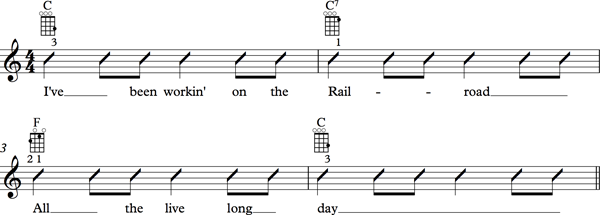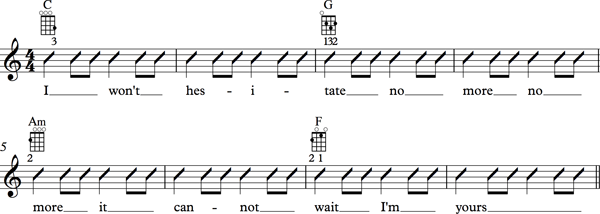For the most part, ukulele songs are displayed online and in print using chord charts. A chord chart includes the lyrics of a song with letters above to indicate the chords. Most of the ukulele songs I’ve posted on Ukulele Tricks are presented through chord charts.
The big downside to chord charts is that there is no indication of the rhythm (or strumming) of a song. By itself, a chord chart doesn’t inform you about how long to strum a chord or when to exactly change a chord. The chord letters are written to line up with the lyrics, as to try to indicate when the chord changes happen, but as you’ve probably found, it’s not that easy.
In this lesson, I show you some ways I go about approaching a chord chart and learning a new song. More specifically, I give you some practical examples and exercises from actual songs that allow you to get the knack for identifying chord changes in a song, while keeping a steady strumming pattern rhythm.
The following figure shows the strumming pattern I will use as an example in this lesson. If you are a complete beginner and need some direction, watch this video lesson before proceeding, which demonstrates the following strumming pattern:

3 Main Ways Chord Changes Happen In Songs
When you approach a chord chart, you need to know three of the most popular ways chords change throughout a song. Most songs have chord progressions that follow these three rules.
Changing Chords Every Measure
Most songs are counted in four (4/4 time signature). This means you count one, two, three, four to the rhythm or strumming of the song. In a song counted in four, each group of four beats is considered one measure. The strumming pattern in the figure above is played over the span of one measure.
If this talk about counting and measures is confusing, be sure to watch my video lesson Ukulele Strumming Patterns for Beginners.
As a rule of thumb, the majority of chords in a song change on the first beat of a measure. For example, in the popular folk song “I’ve Been Working On the Railroad”, in the first line of the song, chord changes occur on the first beat of every measure, as shown in the following figure:

If you click over to the chord chart for “I’ve Been Working On the Railroad”, you see how the above rhythm chart example is represented in the chord chart:
C C7
I've been working on the railroad
F C
All the live long dayChanging Chords Every Two Measures
While chords often change on the first beat of a measure, chords in a song don’t always change every measure. Sometimes you strum a chord for more than one measure. The following example shows a Jason Mraz “I’m Yours” chord progression, where each chord is strummed for two measures. This means you play the strumming pattern twice for each chord.

If you were just following a chord chart for “I’m Yours”, this is how the above would look:
C G Am F
I won't hesitate no more, no more; it cannot wait I'm yoursChanging Chords In the Middle of a Measure
Chord changes sometimes happen in the middle of a measure–often times on the third beat. For example, in the first lines of “Ain’t She Sweet”, there is an occasional chord change on the third beat:

And this is how this progression would look in a chord chart:
C6 Edim G7
Ain't she sweet
- C6 Edim G7
See her walking down the streetLearning to Play a Song from a Chord Chart
Learning a song from a chord chart is actually pretty difficult–even for a seasoned ukulele player. This is because a chord chart gives you no indication of the rhythm of the song or how the song is counted. Because of this, it becomes a bit more difficult to find a strumming pattern that fits with the song.
Here’s how I approach learning a new song, which allows me to find the right strumming pattern for a song.
Tip #1: Listen, Listen, Listen
So you’ve found the chord chart of your favorite song, and you want to figure out how to play it on ukulele. Before even picking up your ukulele, at first, you must listen to the song. Find a recording of the song on YouTube or download it off of iTunes.
As you listen, do the following things:
- Tap your toe to the beat. Try to count along to a count of four. If that doesn’t quite fit, try a count of three to see if it fits better.
- Pay attention to where chord changes happen. When you hear a “shift” in the harmony or melody, this usually means a chord has changed.
- Sing or hum the melody of the song. The tricky part is to sing and strum at the same time, so you’ll want to have the melody of the song ingrained in your brain so it’s second nature.
Listening is so important because it gets the song stuck in your head. It also allows you to pick up on things like rhythm and melody, which will inform you for the next step.
Tip #2: Start with Down Strums
Once you’ve listened to the song, take a look at the chord chart for the song and start learning the chords. When you are comfortable, start strumming the first chord of the song with just down strums.
Always start with down strums. Strumming isn’t about being fancy. It’s better to be able to play a song with just down strums rather than playing a really fancy, complicated strumming pattern that is played out of rhythm.
Practice changing between the chords of the song. As shown in the examples above, try switching the chords on the first beat of every measure. If that doesn’t feel right, try switching chord every two measures, and if that’s not working, experiment with changing chords in the middle of a measure.
At this point, you are just trying to get a sense for how and when the chords change. You are going to have to experiment. Use your ear, and don’t be afraid to go back and listen to the song.
Tip #3: Strum First, Sing Later
The tricky part about any song is that more often than not, the rhythm of the melody of the song (the part you sing) is a little different than the strumming. This means your singing won’t always match up completely with your strumming. This complexity is normal in any piece of music and is often what makes a piece worth listening to.
When it comes to singing and playing at the same time, it’s important you’ve practiced your strumming to the point where it becomes second nature. This way when you try singing a vocal line you don’t get thrown off. It’s a lot like patting your head and rubbing your stomach at the same time!
For more on singing and playing the ukulele at the same time, check out my lesson How to Sing and Play Ukulele At the Same Time.
Conclusion
A lot of the ideas presented in this lesson are unpacked more in my comprehensive video lesson course Ukulele Strumming Tricks. If you are a complete beginner, or if you want to have a more in-depth understanding of rhythm and strumming on the ukulele, I recommend joining me in my course.
How’s the strumming going for you? What questions do you have? Do you have any tips that I might have missed? Post your comment below.

